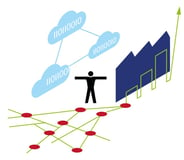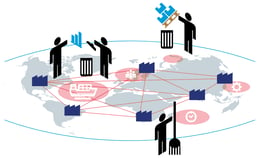3 Reasons Supply Managers Should Adopt A Postmodern ERP Mindset
Nick Ostdick - March 15, 2016


On a recent cross-country flight, I was seated next to a supply chain manager for Company X who, after furiously typing away on his laptop for an hour or so, expressed concern about his company's current ERP (enterprise resource planning) solution and strategy and whether it was well-suited to meet the demands of today’s global supply chain.
This planner told me his biggest fears about his company's ERP model was its ability to remain lean, agile, and cost-effective in conceiving and implementing planning solutions and strategies. This planner is not alone in his anxiety. A recent Gartner survey indicated ERP efficiency ranked fourth overall among the top concerns of manufacturers and suppliers.
So what is a planner to do when looking to modernize or retrofit existing ERP solutions for today’s rapidly-changing supply and logistics landscape? The answer lies not necessarily in a specific action, but more in a mindset, particularly that of postmodern ERP philosophies.
Adopting a postmodern ERP philosophy requires planners to conceive a more centralized and streamlined strategy for data and information processing and storage - whether cloud-based or otherwise. Where traditional ERP systems operate off several different interfaces and platforms, a postmodern ERP mindset provides for a flexible informational and operational structure that can be adapted, adjusted, or revised without disrupting the structural or architectural integrity of existing systems within an organization.
To put it another way, traditional ERP strategies are stone and postmodern ERP strategies are rubber - they’re pliable, flexible, and allow for maximum maneuverability, which any planner will tell you is the name of the game in today’s global supply stream.
The benefits and value-added propositions from incorporating postmodern ERP thinking are numerous and can have ripple effects across a company’s entire organizational structure. However, here are just a handful of reasons why supply chain planners should adopt a postmodern ERP mindset.
1). Increased visibility: Moving toward a postmodern ERP mindset means centralizing all planning decisions in one location via cloud technology, which not only offers greater visibility and transparency across all points of the supply chain but it also allows for more multiple data points via one source. Those at manufacturing, distribution, and freight points can input data in real-time which can then be accessed by anyone at any point in the supply stream. This is key in creating end-to-end visibility and agility, but it’s also an important driver in increasing communication and collaboration which will reduce the likelihood of errors or disruptions, which can be quite costly in terms of time, money, and resources.
2). Increased integration: Perhaps as a consequence of the rigidity of traditional ERP strategies, more and more companies are exploring substitute or third-party vendor solutions in search of best-of-breed solutions for specific functional areas without impacting a company’s overall structural foundation. Though many ERP vendors claim their integrated system is a superior solution, these often detached, disparate modules rarely provide the capabilities for cross-functional integration throughout an organization. Postmodern ERP thinking, in combining cloud-based and on-premise capabilities, not only helps reduce operating costs by streamlining automated processes and information and data storage, but also helps breakdown functional silos and barriers to communication and collaboration.
3). Increased flexibility: As we mentioned, the importance of flexibility in the supply stream cannot be understated, and incorporating postmodern ERP thinking into your planning strategy provides greater flexibility than traditional ERP models. With the concept of postmodern ERP, software, modules, and solutions can be added, subtracted, or augmented without risk of disruption to a company’s entire operation. Essentially, with traditional ERP systems, modifications, upgrades and similar functions are like playing a game of Jenga - remove one block and the entire tower could come crumbling down. Postmodern ERP strategy allows for component parts to be moved around with ease while still maintaining maximum functionality and operational capacity.
So, if I was to attempt to address the concerns my neighbor on that recent flight had about getting the most out of his traditional ERP strategy, perhaps I’d tell him the term ERP was coined by Gartner in 1990 and that so much has changed since then that traditional ERP philosophy is no longer a competitive advantage. Planners must now leverage a postmodern ERP strategy to help lower cost, increase efficiency, and create more holistic solutions for today’s complex supply issues.
flexis offers a wide range of easily implemented solutions and strategies to compliment existing traditional or legacy ERP systems. These solutions embody the principles and values of postmodern ERP thinking, and can be a key driver in promoting efficiency, growth, and profitability.
LATEST POSTS
- Understand Circular Economy in The Manufacturing Industry
- How Can Industry 4.0 IT Integration Be Achieved Smoothly?
- The Significance of Order Sequencing in Discrete Manufacturing
- How to improve your Supply Chain Management: The Power of Control Towers
- Optimizing Human Resource Scheduling in Manufacturing: A Technological Approach



